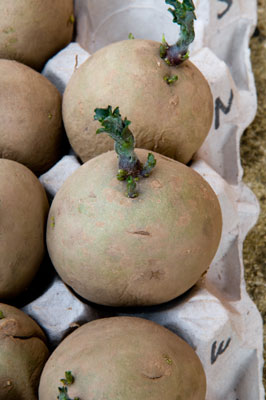When estimating how many seed potatoes you need, assume that you will receive between 12 & 16 tubers for each Kilogram, depending on variety.
After chitting (see below), potatoes should be planted 10-15cm (4-6 inches) deep in rows with the following distance between each tuber.
- First Early - 30cm (12 inches)
- Second Early - 38cm (15 inches)
- Main Crop - 38-45cm (15-18 inches)
Each row should be 50-60cm (18 inches - 2 feet) apart (Earlies) and 68-76cm (27-30 inches) apart (Maincrop).
Seed Potato varieties vary, as available.
Detailed information about many seed potato varieties is available as a MS Word document.
Chitting Potatoes
 From late January seed potatoes will be in the CHS Shop and a list of the varieties it is hoped to be stocked is now available. For the benefit of new vegetable growers, here’s how you get them going.
From late January seed potatoes will be in the CHS Shop and a list of the varieties it is hoped to be stocked is now available. For the benefit of new vegetable growers, here’s how you get them going.
Chitting is simply another name for ‘sprouting’ or giving your spuds a kick-start. Some growers say this process should be done in the dark, e.g. in a cupboard or under the stairs while others advocate leaving them in a light but frost-free place. Personally, I prefer the latter because with the “in the dark” method if they are not checked regularly they could quickly develop long straggly shoots which may easily break off when planting out. I usually stand mine on a windowsill.
Whichever method you choose, stand the tubers with the buds or “eyes” upright in a seed tray or similar container – egg boxes are ideal. If there are eyes all over the tuber, choose the end with the most. Sprouting will take about six weeks during which time you should check them regularly rubbing out all but the 3 or 4 strongest shoots. I tend to give the tubers a light spray with water from time to time but they should be kept dryer rather than wet. They should be ready for planting out when the shoots are about one inch (2.5cm) long.
Planting time will vary according to the weather and soil conditions, especially for the first earlies. Folk lore suggests that you should not plant potatoes before Good Friday but as this can vary any time between mid March and the end of April, it is not a very practical guide. I would suggest that here in the South of England and subject to weather and soil conditions, mid to late March is about right for first earlies with other varieties spread throughout April for second earlies and May for your main crop. When you go to the Shop you will see the different varieties for first early, second early and main crop listed for you to make your choice.
PETER ARMSTRONG